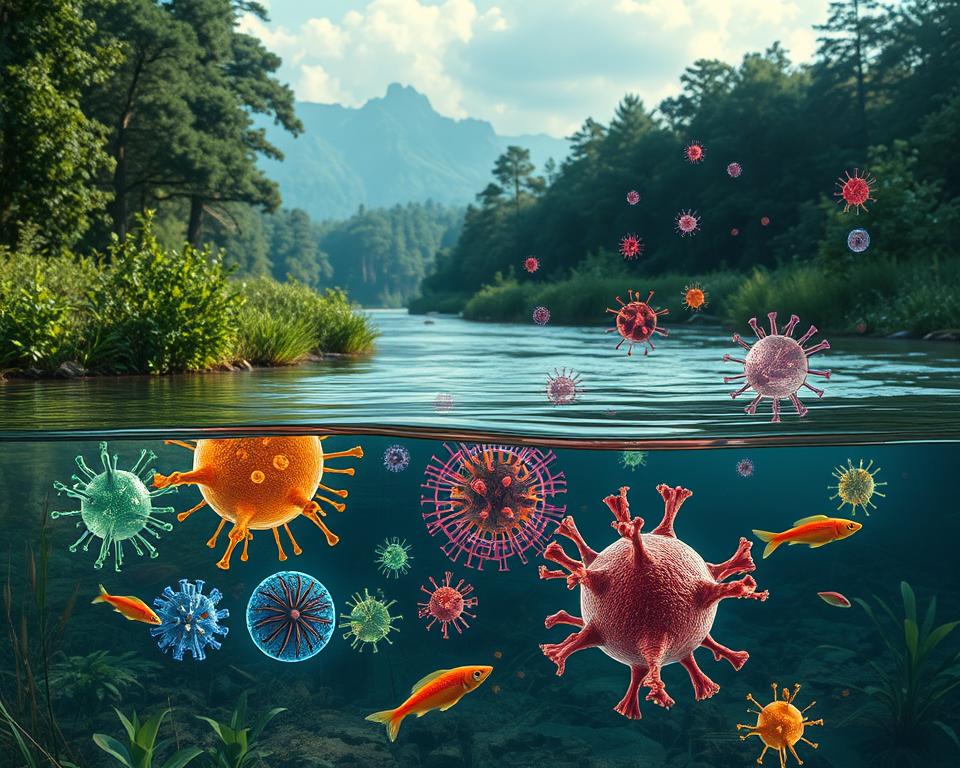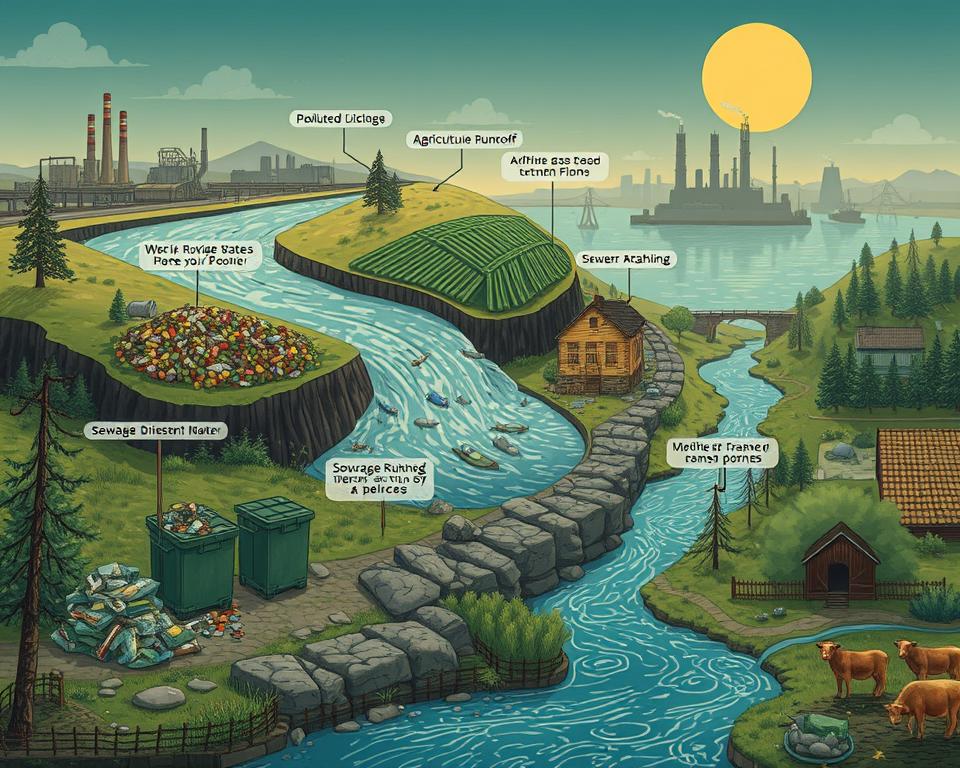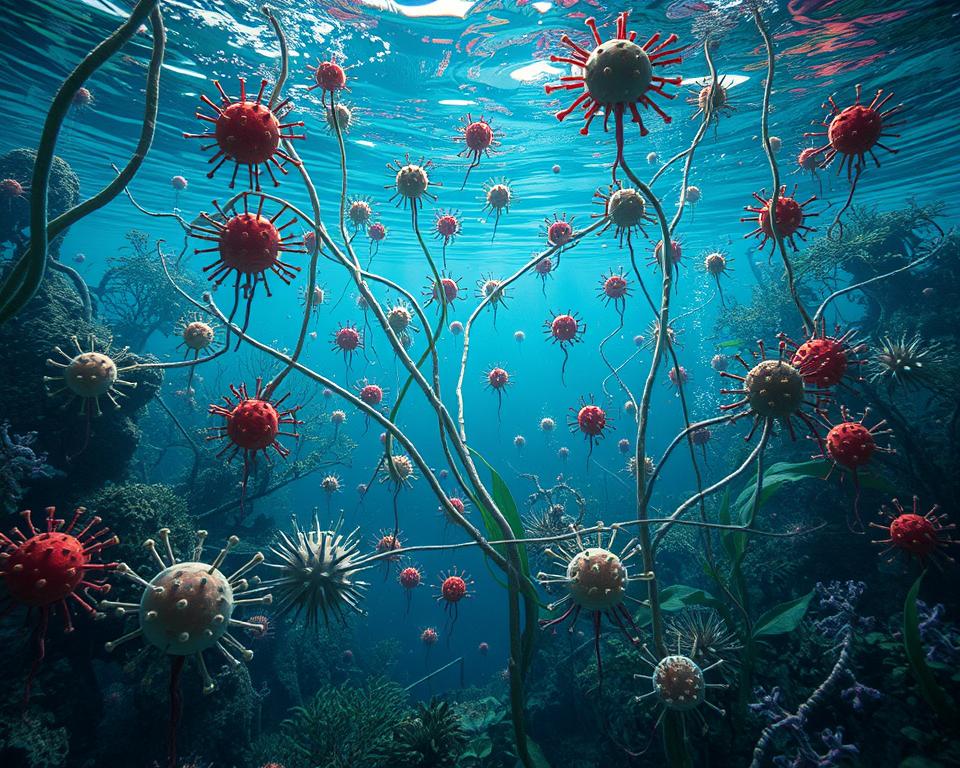Waterborne pathogens pose a big health risk, as noted by the Centers for Disease Control and Prevention (CDC). They lead to waterborne diseases from harmful bacteria, viruses, or parasites. Every year, they affect over 7 million people in the U.S., bringing about serious health threats and economic costs.
The healthcare system faces more than $3 billion in costs each year due to these illnesses. Diseases caused by water contamination can hurt the stomach, lungs, brain, skin, and blood. That’s why it’s vital for policy creators, industry leaders, and health experts to work together to stop these problems.
To prevent waterborne illnesses, we need a strong plan. This plan should include policy makers, public health officials, and businesses working to keep our water safe. With the big impact on people’s health and our economy, knowing the risks and taking action is key for protecting everyone from water pathogens.
Introduction to Waterborne Pathogens
Waterborne pathogens can be harmful. They spread diseases through drinking water and swimming areas. The impact of climate change and water pollution makes it vital to understand these germs.

Definition and Basics
The CDC tells us that waterborne pathogens cause diseases from contaminated water. This includes bacteria, viruses, and parasites. Exposure to these pathogens can happen by swallowing, breathing in mists, or direct skin contact. This exposure results in sicknesses like Legionnaires’ disease and dysentery.
These pathogens can enter a water system during construction or from poor water quality. Keeping water clean helps prevent these dangers. It’s key to public health.
Public efforts work to lower the risk from waterborne pathogens. They keep an eye on water quality and provide drinking water standards. They also offer safe fish eating and swimming advice.
Types of Waterborne Pathogens
Waterborne germs are mainly bacteria, viruses, or parasites. Some, like Acinetobacter, can thrive in water pipes. Each type poses different risks.
- Bacterial Contamination: E. Coli can cause serious stomach issues.
- Viral Pathogens: Diseases like norovirus and hepatitis A can spread in dirty water.
- Parasitic Organisms: Germs like Giardia cause serious illness, especially in those with weak immune systems.
Good water management and treatment are key to stopping these pathogens. The CDC offers a guide on setting up these programs in healthcare settings. Here, it’s very important to protect patients.
Fixing and saving wetlands helps clean water and captures carbon. This approach improves water safety and addresses climate issues.
Controlling waterborne germs involves checking water and taking safety steps. Groups like the Council of State and Territorial Epidemiologists provide guidance on this.
Climate change may cause more water illnesses, highlighting the need for effective water solutions.
The Evolution of Waterborne Diseases in the U.S.
The story of waterborne diseases in the U.S. has changed a lot. This is because of better water systems, cleaner practices, and new ways to kill germs. We moved from terrible cholera and typhoid times in the early 1900s to today’s issues with Legionella and germs that cling to surfaces inside pipes. Let’s explore how these diseases journeyed through time. We’ll look at their impact on history, their role in modern days, and how our water systems have evolved.
Historical Context
In the early 1900s, cholera and typhoid fever were big problems in the U.S. Back then, we didn’t have good sanitation or water systems. But, introducing ways to clean water, like using chlorine, helped stop these diseases. Thanks to these actions, illnesses from bad drinking water dropped a lot.
Modern-Day Impact
Even with progress, waterborne diseases still affect us today. From 2015 to 2020, health professionals found 214 disease outbreaks from drinking water. These caused over 2,000 people to get sick, leading to 563 needing hospital care, and 88 deaths. Biofilms were involved in 87% of these outbreaks. Legionella is now a common cause, showing we still face big challenges in keeping our water clean, especially with today’s complex water systems.
Changes in Water Systems
Waterborne diseases and water systems are closely connected. Better water treatment and cleaner practices have made our water safer. Yet, newer, complex systems in buildings add new risks. Many outbreaks happen at specific points in these systems. This shows we must keep disinfecting and watching our water systems carefully. Doing this helps lower the risk of getting sick. Learn more about keeping water systems safe.
| Year | Total Outbreaks | Legionella Outbreaks | Enteric Illness Outbreaks | Hospitalizations | Deaths |
|---|---|---|---|---|---|
| 2015 | 14 | 31 | 1 | 52 | 11 |
| 2016 | 31 | 30 | 1 | 53 | 10 |
| 2017 | 30 | 34 | 1 | 55 | 9 |
| 2018 | 34 | 33 | 2 | 54 | 8 |
| 2019 | 33 | 18 | 0 | 52 | 7 |
| 2020 | 18 | 14 | 1 | 44 | 7 |
Transmission and Exposure Routes
It’s vital to understand how waterborne pathogens spread to prevent them effectively. They can spread by drinking contaminated water, doing water sports, and other less usual ways.
Drinking Contaminated Water
Drinking dirty water is a major way people get sick from water. Places using groundwater have more sickness than those using water from lakes or rivers. Studies show bugs like nontuberculous mycobacteria caused about 9.6% of these sicknesses, and Salmonella caused 8.0%.

Water systems are closely linked to diseases like Legionnaires’, which went up by 124% when the ground was wetter. Using groundwater can triple the chance of getting cryptosporidiosis compared to lake or river water.
Recreational Water Activities
Water sports like swimming and boating can make people sick. These fun activities can cause people to breathe in water droplets. This lets germs get into the lungs. In fact, nearly 81% of hospital cases were because of biofilm-forming bacteria. Respiratory infections from Pseudomonas made up 60% of these.
A study showed that sources of water contamination from recreational waters often come from human and animal waste. Poor water treatment adds to the problem.
Other Common Exposure Routes
Other than drinking and water sports, there are more ways to get exposed. Breathing in mist from showers or cooling towers can cause sickness. Legionella, often spread this way, caused 4.1% of sickness-related hospital stays. Getting water in your ears or nose during washing or bathing also raises the risk. It highlights the importance of good prevention strategies.
Studies indicate that small, rural hospitals see more of these infections. This points to the impact of location and infrastructure on sickness rates and outcomes. Better tracking and public education on how these pathogens spread can help lower the risks.
Health Risks Associated with Waterborne Pathogens
Waterborne pathogens bring several health dangers. These include stomach issues, lung diseases, brain effects, and skin problems. Each illness impacts differently and requires special care and treatment.
Gastrointestinal Illnesses
Stomach problems like diarrhea, vomiting, and cramps are common from water germs. Illnesses such as giardiasis, cryptosporidiosis, and shigellosis hit the digestive system hard. They cause a lot of pain. At their worst, they lead to dehydration and even hospital stays.
In the U.S., there were 42 outbreaks from drinking water reported in 2013–2014. These caused over 1000 people to get sick and a few even died.
Respiratory and Neurological Impacts
Water germs can also cause lung diseases, like Legionnaires’ disease. This is a serious lung infection caused by Legionella bacteria. It’s deadly, especially for the elderly or those with weak immune systems.
Brain effects from these pathogens are rarer but serious. They show the need for strict water checks. Since Legionella lives in natural and artificial water bodies, controlling it is key.
Skin and Bloodstream Infections
Waterborne pathogens can also lead to skin and bloodstream infections. Take Vibriosis in Alabama, for example. It can cause severe infections in open wounds exposed to tainted water. These Vibrio infections might be overlooked but need fast medical help.
Regular water quality checks with tools like real-time PCR and biosensors can spot these germs early. This helps stop bigger outbreaks.
To find out more about keeping water safe, check this complete guide on choosing safe water options.

